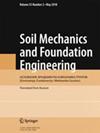利用脉冲响应测试评估板-土接触的完整性:数值模拟的启示
IF 0.6
4区 工程技术
Q4 ENGINEERING, GEOLOGICAL
引用次数: 0
摘要
为了评估脉冲响应测试对地基板下潜在不良支撑区或空洞的敏感性,我们使用有限元方法进行了数值模拟。这些模拟涵盖了一系列情况,包括土壤松动区、板下空洞和板裂缝。对模拟结果的分析采用了两种不同的技术:归一化声学响应方法和 ASTM C1740 移动频谱方法。通过这些方法,可以根据合成模型中的规格描述输入信号变化所产生的参数和属性。本文章由计算机程序翻译,如有差异,请以英文原文为准。
Evaluating the Integrity of Slab–Soil Contact with Impulse Response Testing: Insights from Numerical Simulations
To assess the sensitivity of impulse response testing to potential poor support zones or voids beneath the foundation slabs, numerical simulations were performed using the finite element method. These simulations covered a range of scenarios, including soil-loosening zones, sub-slab cavities, and slab cracks. The analysis of the simulation results employed two distinct techniques: the normalized acoustic response method and the ASTM C1740 mobility spectrum approach. These methods allowed the parameters and attributes derived from changes in input signals to be described in relation to the specifications within the synthetic models.
求助全文
通过发布文献求助,成功后即可免费获取论文全文。
去求助
来源期刊

Soil Mechanics and Foundation Engineering
ENGINEERING, GEOLOGICAL-
CiteScore
1.50
自引率
12.50%
发文量
65
审稿时长
6 months
期刊介绍:
Soil Mechanics and Foundation Engineering provides the Western engineer with a look at Russian advances in heavy construction techniques. Detailed contributions by experienced civil engineers offer insights into current difficulties in the field, applicable innovative solutions, and recently developed guidelines for soil analysis and foundation design.
 求助内容:
求助内容: 应助结果提醒方式:
应助结果提醒方式:


